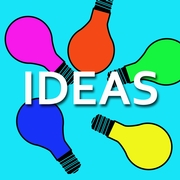Facilitation Quick Tips: Board of Ideas
By Regina Firpo, MPH, CNC, MCHES | January 26, 2015
Director of Innovations, ETR
This is a group activity that can be used for reflection, idea generation, problem-solving, consensus-building and affirmation. It can also provide a nice change of pace for the group’s energy because it is both silent and physically active.
I learned this activity from Mary Harthun, a master educator at Arizona State University. I’ve used it many times in trainings and in day-long workgroup meetings, with both adults and youth. It allows participants to reflect, share and construct a compilation of what they’ve learned.
I present the activity below as a summary activity for a training or training day, but also describe other ways it can be used.
Title: Board of Ideas
Setting: Appropriate for in-person events and adaptable for live virtual events
Time: 15 minutes (but this is flexible, depending on complexity of the question posed and number of participants)
Purpose:
- To engage participants in a reflective and collaborative process for learning reinforcement, idea generation or problem-solving.
- To construct a visual representation of the group’s ideas (e.g., what they have learned, how to solve a problem, how to create agreements). In the examples below, I focus on reflection and learning reinforcement.
- To engage participants in a unique way that provides variety in the training event.
Best Used:
- This activity works well with groups of 10-30 participants, in a space that allows everyone to easily see the white board. It can also be used in live virtual events.
- It’s a powerful activity with youth. They love it!
Materials Needed:
- Large, clean white board
- Many brightly colored markers
Preparation:
Determine the trigger question to post on the board. For instance:
- What are the most important things you learned in today’s training?
- How will you do your job differently as a result of this training?
- How has this training prepared you to______________________ ?
Steps
- Introduce the activity as a reflection and summary activity that allows participants to share and see what they have learned. Explain that you will post a question on the board. Participants are invited one at a time (or two if it is a very large board and a large group) to silently approach the board and write an idea about the question on the board.
Explain that they may:
- Approach the board as they feel ready.
- Use any color marker they choose.
- Underline a concept they agree with.
- Use arrows to add more information or examples.
- Add questions (e.g., “Can someone explain this?” “Does anyone else think that_________________ ?”).
- Approach the board several times if they wish, being considerate of others who haven’t contributed yet.
Explain they may not:
- Cross out or negate an idea they do not agree with (though they can add a question next it).
- Talk.
- Use cell phones or other distracting devices.
- Check for understanding to make sure everyone understands the directions.
- Post the trigger question on the board and invite participants to begin. Let them know they have about 10 minutes to contribute their ideas.
As with verbal group discussions, sometimes there will be lulls in participation in this activity. It’s okay to give participants time to think.
- Conclude the activity when time is up, the board is packed full, or the participation has slowed to a natural ending point.
- Invite participants to verbally share their reactions to the activity.
- Take a picture of the board of ideas and make the image available to interested participants.
Variations
Here are examples of questions that can be used in this activity to achieve other goals, such as idea generation, problem-solving, consensus-building or affirmation.
Problem-Solving
- How can we retain youth in our program?
- What are ways to handle________________________ ?
Idea Generation
- How can we help our friends prevent pregnancy? (for a group of youth)
- If you had a million dollars to spend to improve our program, how would you spend it?
Consensus-Building
- What group agreements would you like in place for this training?
- What are some ways we could share our group’s concerns with the administration?
Affirmation
- If we were going to give a TED Talk and use our program to inspire and inform others, what would we want to say?
- What are some words or phrases that come to mind when you think about the positive impact we will have when we implement this program?
Using the Activity in Live Virtual Events
For a completely remote event, such as an instructor-led virtual training (e.g., live webinar), this activity can be modified for a shared white board. Instead of approaching the board physically to post ideas, participants use the drawing tools to add their ideas to the shared white board.
Regina Firpo-Triplett, MPH, CNC, MCHES, is the Director of Innovations at ETR. She can be reached at reginaf@etr.org and found on LinkedIn





